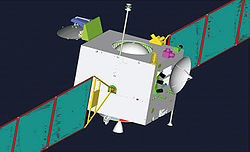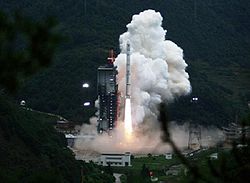- Chang'e 1
-
Chang'e 1 
Operator China National Space Administration (CNSA) Mission type Orbiter / impactor Satellite of The Moon Launch date 2007-10-24, 10:05:04.602 UTC Carrier rocket Long March 3A Launch site Xichang Satellite Launch Center, Launch Pad 3
Xichang, The People's Republic of ChinaMission duration 2009-03-01, 08:13:10 UTC
1 year, 4 months, 4 days, 22 hours and 7 minutesCOSPAR ID 2007-051A Homepage CLEP Mass 2,350 kg Orbital elements Inclination ~64° Apoapsis ~200 km Periapsis ~200 km Orbital period ~127 minutes References: [1][2] Chang’e 1 (pronounced roughly chang-uh, [tʂɑ̌ŋ.ɤ̌]; simplified Chinese: 嫦娥一号; traditional Chinese: 嫦娥一號; pinyin: Cháng'é yī hào) was an unmanned Chinese lunar-orbiting spacecraft, part of the first phase of the Chinese Lunar Exploration Program. The spacecraft was named after the Chinese Moon goddess, Chang'e.
Chang'e 1 was launched on 24 October 2007 at 10:05:04 UTC from Xichang Satellite Launch Center.[3] It left lunar transfer orbit on 31 October and entered lunar orbit on 5 November.[4] The first picture of the Moon was relayed on 26 November 2007.[5] On 12 November 2008, a map of the entire lunar surface was released, produced from data collected by Chang'e 1 between November 2007 and July 2008.[6][7]
The mission was scheduled to continue for a year, but was later extended and the spacecraft operated until 1 March 2009, when it was taken out of orbit. It impacted the surface of the Moon at 08:13 UTC.[2] Data gathered by Chang'e 1 was able to create the most accurate and highest resolution 3-D map ever created of the lunar surface.[8] Its sister orbital probe Chang'e 2 was launched on the first of October 2010.[9]
Contents
Objectives
The Chang'e 1 mission had four major goals:[7][10]
- Obtaining three-dimensional images of the landforms and geological structures of the lunar surface, so as to provide a reference for planned future soft landings. The orbit of Chang'e 1 around the Moon was designed to provide complete coverage, including areas near the north and south poles not covered by previous missions.
- Analysing and mapping the abundance and distribution of various chemical elements on the lunar surface as part of an evaluation of potentially useful resources on the Moon. China hopes to extend the number of elements studied to 14 (potassium (K), thorium (Th), uranium (U), oxygen (O), silicon (Si), magnesium (Mg), aluminium (Al), calcium (Ca), tellurium (Te), titanium (Ti), sodium (Na), manganese (Mn), chromium (Cr), and lanthanum (La)),[11] compared with the 10 elements (K, U, Th, Fe (iron), Ti, O, Si, Al, Mg, and Ca)[12] previously probed by NASA's Lunar Prospector.
- Probing the features of the lunar soil and assessing its depth, as well as the amount of helium-3 (³He) present.[11]
- Probing the space environment between 40,000 km and 400,000 km from the Earth, recording data on the solar wind and studying the impact of solar activity on the Earth and the Moon.
In addition, the lunar probe engineering system, composed of five major systems – the satellite system, the launch vehicle system, the launch site system, the monitoring and control system and the ground application system – accomplished five goals:
- Researching, developing and launching China's first lunar probe
- Mastering the basic technology of placing satellites in lunar orbit
- Conducting China's first scientific exploration of the Moon
- Initially forming a lunar probe space engineering system[clarification needed]
- Accumulating experience for the later phases of China's lunar exploration program
Mission
 The launch of Chang'e 1 at Xichang Satellite Launch Center
The launch of Chang'e 1 at Xichang Satellite Launch Center
According to the schedule, detailed design of the first program milestone was completed by September 2004. Research and development of a prototype probe and relevant testing of the probe were finished before the end of 2005. Design, manufacture, general assembly, test and ground experiments of the lunar orbiter were finished before December 2006.
Originally scheduled for April 2007, the launch was postponed until October as this was "a better time for sending a satellite into the Moon's orbit".[13] Chang'e 1 was launched by a Long March 3A rocket at 10:05 GMT on October 24, 2007 from Xichang Satellite Launch Center in Sichuan Province.
After liftoff, Chang'e 1 made three orbits around the Earth, a burn at perigee extending the orbit's apogee further each time, until a final translunar injection burn placed it on course for the Moon on October 31, 2007. Another burn placed it in a polar orbit around the Moon, with burns at the perilune of the first three orbits decreasing the apolune until it entered a final circular orbit. Lunar orbit insertion was achieved on the November 5, 2007. To mark this occasion, the probe transmitted 30 classical Chinese songs and musical pieces, including "My Motherland", "The Song of the Yangtze River", and "High Mountains and Flowing Water".
The probe was remotely controlled from stations at Qingdao and Kashgar, as the first use of the Chinese Deep Space Network. The ESA Maspalomas Tracking Station was also used to transmit signals to and from the probe.
The first pictures of the Moon were relayed on November 26, 2007. The probe was designed to orbit the Moon for one year,[11] but operations were later extended, and it remained in lunar orbit until March 1, 2009.
End of mission
On 1 March 2009, at 08:13:10 UTC, Chang'e 1 crashed onto the surface of the Moon, ending its mission. According to the State Administration of Science, Technology and Industry for National Defense (China), this was a planned and controlled impact.[14] Impact point was 1°30′S 52°22′E / 1.50°S 52.36°E.[15][16][17] During its orbital mission the probe transmitted 1,400 gigabits or 175 gigabytes (GB) of data.
Design and instrumentation
The Chang'e 1 spacecraft had a mass of 2,350 kg, with a 130 kg payload, carrying 24 instruments including a Charge-coupled device (CCD) stereo camera, microprobe instruments, and a high-energy solar particle detector.
- Stereo camera with an optical resolution of 120 m and spectrometer imager operating at wavelengths of 0.48 µm to 0.96 µm.
- Laser altimeter with 1064 nm, 150 mJ laser, a range resolution of 1 m and a spot size of 300 m.
- Imaging spectrometer
- Gamma and X-ray spectrometer working in an energy range of 0.5 to 50 keV for X-rays and 300 keV to 9 MeV for gamma rays.
- Microwave radiometer detecting 3, 7.8, 19.35 and 37 GHz with a maximal penetration depth of 30, 20, 10, 1 m and a thermal resolution of 0.5 K.
- High energy particle detector and two solar wind detectors capable of the detection of electrons and heavy ions up to 730 MeV.
See also
- Exploration of the Moon
- List of future lunar missions
- Robotic exploration of the Moon
References
- ^ "China's first lunar probe Chang'e-1 blasts off". SINA Corporation. October 24, 2007. http://english.sina.com/technology/1/2007/1024/129176.html. Retrieved 2007-10-24.
- ^ a b Guodong, Du (2009-03-01). "China's lunar probe Chang'e-1 impacts Moon". Xinhua. http://news.xinhuanet.com/english/2009-03/01/content_10923205.htm. Retrieved 2009-03-01.
- ^ "China's 1st Moon orbiter enters Earth orbit". Xinhua News Agency. October 24, 2007. http://news.xinhuanet.com/english/2007-10/24/content_6937622.htm. Retrieved 2007-10-24.
- ^ http://www.efluxmedia.com/news_Chinas_Change_I_Enters_Moon_Orbit_10279.html
- ^ "China publishes first Moon picture". China National Space Administration. November 26, 2007. http://www.cnsa.gov.cn/n615709/n620682/n639462/132125.html. Retrieved 2007-11-26.
- ^ "China publishes first map of whole lunar surface". 12 November 2008. http://mil.news.sina.com.cn/s/2008-11-12/1559529860.html. Retrieved 2008-11-12.
- ^ a b "Chang’E-1 Lunar Mission: An Overview and Primary Science Results" (PDF). http://www.cjss.ac.cn/qikan/manage/wenzhang/2010-05-02.pdf.
- ^ http://www.atimes.com/atimes/China/LD16Ad01.html
- ^ http://www.bbc.co.uk/zhongwen/simp/china/2010/10/101001_china_satellite_moon.shtml
- ^ "Chang'e-1 - new mission to Moon lifts off". European Space Agency. http://www.esa.int/esaCP/SEMPM53Z28F_index_0.html. Retrieved 2007-10-24.
- ^ a b c Sūn Huīxiān (孙辉先), Dài Shùwǔ (代树武), Yáng Jiànfēng (杨建峰), Wú Jì (吴季) and Jiāng Jǐngshān (姜景山) (2005). "Scientific objectives and payloads of Chang'E-1 lunar satellite" (PDF). Journal of Earth System Science 114 (6): 789–794. Bibcode 2005JESS..114..789H. doi:10.1007/BF02715964. http://www.ias.ac.in/jessci/dec2005/ilc-25.pdf.
- ^ D. J. Lawrence, * W. C. Feldman, B. L. Barraclough, A. B. Binder, R. C. Elphic, S. Maurice, D. R. Thomsen (1998). "Global Elemental Maps of the Moon: The Lunar Prospector Gamma-Ray Spectrometer". Science 281 (5382): 1484–1489. Bibcode 1998Sci...281.1484L. doi:10.1126/science.281.5382.1484. PMID 9727970.
- ^ "Chang'e-1 Satellite Launch Delayed". China Radio International. March 15, 2007. http://english.cri.cn/2906/2007/03/15/1261@205784.htm. Retrieved 2007-10-24.
- ^ "China lunar probe mission ends with planned crash". The Associated Press. http://www.google.com/hostednews/ap/article/ALeqM5iZBB3YlRbLgxnFO4CJ0cYG-IQ5qwD96L5NJ82. Retrieved 2009-03-02.
- ^ "NASA NSSDC Master Catalog - Chang'e 1". http://nssdc.gsfc.nasa.gov/nmc/spacecraftDisplay.do?id=2007-051A. Retrieved 2011-01-01.
- ^ "China People's Daily Online, 2 March 2009 - Chang'e-1 impacts Moon (coordinates)". http://english.peopledaily.com.cn/90001/90781/90876/6603492.html. Retrieved 2011-01-01.
- ^ "Smackdown". Aviation Week & Space Technology 70 (10): p. 16. 9 March 2009.
External links
- CLEP Official site
- Chang'e 1 Mission Profile by NASA's Solar System Exploration
- Encyclopedia Astronautica
- The Scientific Objectives of Chinese Lunar Exploration Project by Ouyang Ziyuan
- YouTube video of launch
- Chinese State Media Coverage (CCTV) in English
- Europe, China Cooperate To Radio Lunar Probe
- FACTBOX - Reuters - Planned lunar missions
- Reuters: CHRONOLOGY - Five key dates in the race to the Moon
Robotic exploration of the Moon Programs Orbiters Planned Proposed Flybys Impactors Landers Rovers S. Return Cancelled See also - Moon
- Exploration of the Moon
- Colonization of the Moon
- Manned lunar spacecraft
- List of artificial objects on the Moon
- List of current and future lunar missions
- List of lunar probes
- Apollo
- CCCP manned lunar plan
Bold italics indicates active missions Chinese spacecraft Earth observation Communication and
engineering testData relay satellite system Tianlian-1 (Tianlian I-01)
In development: Tianlian-2Positioning Astronomical observation Double Star (joint ESA)
In development: Solar Space Telescope · Hard X-ray Modulation Telescope · KuafuLunar and planetary
explorationChang'e 1 (Chinese Lunar Exploration Program) · Chang'e 2
In development: Chang'e 3 · Yinghuo 1 · Deep space explorationChinese Lunar Exploration Program Recent missions Chang'e 1 · Chang'e 2Planned missions Components Launch sites People Related topics CNSA ← 2006 · Orbital launches in 2007 · 2008 → Cartosat-2 · SRE-1 · Lapan-TUBsat · Pehuensat-1 | Progress M-59 | NSS-8 | Beidou-1D | THEMIS A · THEMIS B · THEMIS C · THEMIS D · THEMIS E | IGS Radar 2 · IGS Optical 3V | ASTRO · NEXTSat · MidSTAR-1 · FalconSAT-3 · STPSat-1 · CFESat | Skynet 5A · INSAT-4B | DemoFlight 2 | Soyuz TMA-10 | Anik F3 | Hai Yang 1B | Compass-M1 | EgyptSat 1 · Saudisat-3 · SaudiComsat-3 · SaudiComsat-4 · SaudiComsat-5 · SaudiComsat-6 · SaudiComsat-7 · CP-3 · CP-4 · CAPE-1 · Libertad 1 · AeroCube 2 · CSTB-1 · MAST | AGILE · AAM | NFIRE | AIM | Astra 1L · Galaxy 17 | Progress M-60 | NigComSat-1 | Yaogan 2 · Zheda PiXing 1 | Globalstar 65 · Globalstar 69 · Globalstar 71 · Globalstar 72 | Sinosat-3 | Kosmos 2427 | COSMO-1 | STS-117 (ITS S3/4) | Ofek-7 | TerraSAR-X | USA-194 | Genesis II | Kosmos 2428 | SAR-Lupe 2 | Chinasat-6B | DirecTV-10 | Progress M-61 | Phoenix | STS-118 (ITS S5 · SpaceHab LSM) | Spaceway-3 · BSat-3A | INSAT-4CR | JCSAT-11 | Kosmos 2429 | Kaguya (Okina · Ouna) | Foton-M3 · YES2 | CBERS-2B | Dawn | Intelsat 11 · Optus D2 | Soyuz TMA-11 | USA-195 | USA-196 | Globalstar 66 · Globalstar 67 · Globalstar 78 · Globalstar 70 | Kosmos 2430 | STS-120 (Harmony) | Chang'e 1 | Kosmos 2431 · Kosmos 2432 · Kosmos 2433 | SAR-Lupe 3 · Rubin-7 | USA-197 | Yaogan 3 | Skynet 5B · Star One C1 | Sirius 4 | Globus-1M #11L | COSMO-2 | USA-198 | Radarsat-2 | USA-199 | Horizons-2 · Rascom-QAF 1 | Progress M-62 | Kosmos 2434 · Kosmos 2435 · Kosmos 2436Payloads are separated by bullets ( · ), launches by pipes ( | ). Manned flights are indicated in bold text. Uncatalogued launch failures are listed in italics. Payloads deployed from other spacecraft are denoted in brackets. Categories:- Chinese space program
- Chinese Lunar Exploration Program
- Lunar spacecraft
- Unmanned spacecraft
- 2007 in spaceflight
- 2007 in China
Wikimedia Foundation. 2010.



